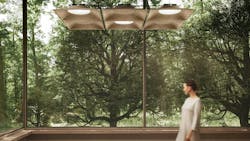The latest eco luminaires feature wool, linen and even water jugs
Luminaire vendors are picking up the pace of making products from environmentally friendly materials, evidenced by Fagerhult Group’s recent announcements of wool in one case and linen in another, and by Signify’s manufacturing of a pendant from what it calls “used water jugs.”
Habo, Sweden–based Fagerhult operates 12 lighting brands, including four in its high-end design- oriented Collection division. Two of those, the Italian company iGuzzini and Sweden’s ateljé Lyktan, are now featuring natural materials in a couple of new luminaires.
Fagerhult CEO Bodil Sonesson featured the new iGuzzini Light Shed Linen as an innovation highlight in her summary of the fourth quarter ending Dec. 31 when she presented financial results a couple weeks ago.
“iGuzzini kept up the pace of innovation by launching ‘Light Shed Linen,’ a high energy-efficient luminaire with the body made from bio-material linen, meaning from a renewable source,” she said.
Sustainability analysts might debate the “greenness” of any environmental claim by examining lifetime value chain use of raw materials, land, emissions, and so forth. That aside, the introduction of bio-based products such as Light Shed Linen seems to be advancing the concept of eco-mindedness; at the least they are raising the discussion level.
IGuzzini’s website described Light Shed Linen as a product made from the flax plant, noting that it therefore “contributes greatly to the reduction of carbon footprint and water footprint.
“To grow, flax needs only rainwater, and no artificial irrigation,” Recanati-based iGuzzini states. “Flax is also very sturdy and therefore needs no pesticides or fertilizers, so it preserves soil and groundwater too. Flax is as light as a feather.”
At ateljé Lyktan, the focus was on avoiding considerable waste from the Swedish wool industry, when it introduced its new Hood and Hood mini luminaires for the commercial market last month.
“The thick fleece of the sheep is sheared twice a year, but barely half of the wool is used,” the Åhus, Sweden–based company said in describing conventional practices. “Over 50% of wool is burned or discarded in Sweden, while a significant amount is imported from abroad. Through our work with Swedish wool as a material, we hope to contribute to a positive change.”
The new Fagerhult Group luminaires are not the first “green” ones from the company in the last year. They follow the introduction of the Kvisten luminaire, made from eco-certified wood, by the company’s eponymous Fagerhult brand.
Likewise, when Signify CEO Eric Rondolat featured the Spring Oasis pendant in his fourth quarter presentation, he was adding to a growing Signify stable of luminaires made from sustainable materials.
As LEDs Magazine reported, Spring Oasis is a 3D printed pendant light for home use made with materials from what Signify describes as “used water jugs”.
It echoes the introduction a year or so ago of the Coastal Breeze pendant, also 3D printed, and made from discarded nylon fishing nets.
As part of the trend, Oslo, Norway–based Glamox last year started using recycled aluminum in some of its luminaires.
MARK HALPER is a contributing editor for LEDs Magazine, and an energy, technology, and business journalist ([email protected]).
Follow our LinkedIn page for our latest news updates, contributed articles, and commentary, and our Facebook page for events announcements and more. You can also find us on the X platform.
About the Author

Mark Halper
Contributing Editor, LEDs Magazine, and Business/Energy/Technology Journalist
Mark Halper is a freelance business, technology, and science journalist who covers everything from media moguls to subatomic particles. Halper has written from locations around the world for TIME Magazine, Fortune, Forbes, the New York Times, the Financial Times, the Guardian, CBS, Wired, and many others. A US citizen living in Britain, he cut his journalism teeth cutting and pasting copy for an English-language daily newspaper in Mexico City. Halper has a BA in history from Cornell University.
